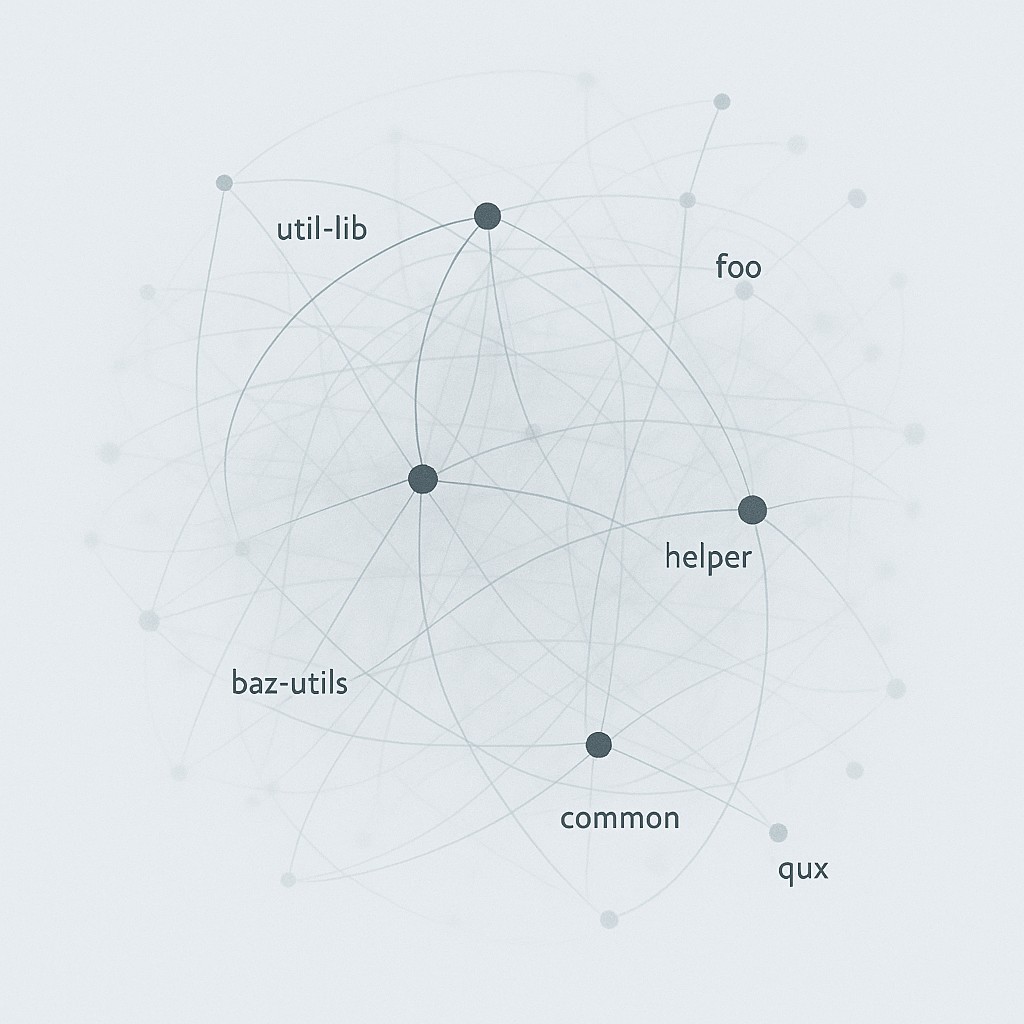Own Your Layer: How to Handle Abstraction Failures
Own Your Layer: How to Handle Abstraction Failures

The Real World Isn’t Clean – And Neither Are Our Dependency Graphs
Last week, I found myself deep in a LinkedIn thread that had more heat than light. The question at the center was this: How to handle abstraction failures when you use AI tools or new packages without knowing every internal detail? Half the voices pushed for total mastery, as if that was even possible. The other half laughed off the idea of knowing every nut and bolt in a real system. If you’ve scrolled one of those debates, you know how quickly everyone stakes out their camp. And if you build software, you know the fatigue—this is way bigger than just AI. It’s about everything we layer and stitch.
Then—I’ll be honest—I opened up package-lock.json. For the Python folks, there’s always poetry.lock. I scrolled, and scrolled, until I was staring at hundreds of dependencies. Nests inside nests, names that barely registered. I’ll say what I always privately knew: I cannot explain half of what’s in there. Never could.

Does that make me careless? I don’t think so. But the anxiety hits anyway. When the expectation is “know every corner of the stack,” you will always feel like an imposter. There’s quiet gatekeeping in those lists that say you’re supposed to know everything about web tokens, drivers, libraries, even whatever third-party AI someone snuck in last quarter. It’s impossible, but easy to pretend. Honestly, it just breeds distraction more than confidence.
But what really matters is knowing how to handle abstraction failures, not whether you can recite every JWT edge case. It’s: can you explain what happens in your system when JWT fails? When your auth token isn’t quite right—does the whole thing collapse or do your boundaries hold? Ownership doesn’t mean omniscience. It means control when things fall apart.
Right now, my focus is resilience, not guilt. By the time you hit the end of this post, my hope is simple: you’ll own your layer, and ship systems that stay up, even when everything underneath goes sideways.
Own Your Layer: What That Really Means
Design for abstraction failures—not by memorizing every line in your package.json or poetry.lock. It’s shaping what flows between your code and the outside world—how you set up interfaces, capture signals, and (honestly the most critical part) how your system bounces when something below burps. You automate recovery, simulate failure, scale out for availability, automate infra tweaks—all these things directly boost reliability and risk control. That’s the job, and it’s the only piece you’ll ever actually get right.
And you can’t dodge the critique that hides in every technical debate. There’s always someone who says, “You built with AI but you don’t even know how JWT works.” It stings. I get that. I keep seeing posts talking about “stacking tech debt” just because you didn’t read every RFC. I used to think deeper knowledge meant safety, but that kind of anxiety leads nowhere good. You’ll freeze, or spin trying to chase every rabbit hole. It’s much more important that your layer survives when the underlying stuff breaks. That’s what sticks.
Six months ago, I’d have argued harder for more hands-on deep dives. Lately? The boundaries matter more, because AI just accelerated everything—the easy wins, and the breakages. The stakes changed faster than our habits.
My boundary is simple. Trust abstractions enough to use them. Then double-check what happens at your team’s edge. Make your assumptions and interfaces visible—especially near the seams where your code meets the rest. If one dependency slips or flips its contract, your service stays up. You don’t have to understand every cryptographic primitive inside your stack, but you do need a system for when those primitives drift or degrade—guardrails, clear signals, monitoring, and fallback. If things break deep, your code detects, contains, and recovers before everything falls down. That’s engineering. In the world we build in now, it’s the only way forward.
Detect, Contain, Recover: How to Handle Abstraction Failures — The Practical Mindset
Let’s talk tokens. JWT fails are the sort of thing everyone expects to just work, until they don’t. Maybe your token expired a second before the client’s clock ticked over. Maybe a payload got mis-signed thanks to half-finished secret rotation. Maybe time zones create a debugging nightmare. When it happens, don’t chase the root cause immediately. Keep the basics: return useful errors, log enough detail to say “something’s off,” and stop the client from slamming endless retries. The job isn’t to know everything. It’s to secure the boundaries. If a token misbehaves, detect it, contain the problem, recover with a fresh login. Not glamorous, but it keeps you up.
Date math: forever a mess. I once tried to patch from moment.js to date-fns because it seemed cleaner and lighter. Three weeks later, timezones chewed up user IDs and a monthly SLA slipped without warning. I found out in the weirdest possible way—our support team got a message about invoices generated for “the wrong Wednesday.” The fix wasn’t elegant. But it forced me back to fundamentals. Sometimes the bits you assume are simple are the ones fated to explode. I still hesitate every time I tweak a date library. Maybe I overcompensate now; I’m not sure that’s resolved.
The pressure to be a master engineer gets tossed around. Systems should be usable, not require you to know quantum physics behind every abstraction. I use a microwave every week. Never once did I read about the electron flow before reheating coffee.
Crypto is another whirlwind. You wake up, find your cryptographic library has deprecated a hashing algorithm, and suddenly every signature is suspect. Warnings everywhere, compliance pinging you with questions. The right move isn’t panic—it’s managing dependency failures with clear boundaries. Log the surface area, batch updates, roll back as needed, and always keep a record. A cryptographic update isn’t the end—it’s maintenance, if your recovery plan works.
Resilience with AI abstractions matters because AI breaks differently. Latency spikes, schema changes happen on some mystery internal project, or data starts drifting in ways nobody predicted. Do your services fail closed, quarantining the issue, or fail open, pushing weirdness everywhere? You don’t win prizes for reading every line of AI internals. You win if your service detects failure, walls it off, recovers, and your customers never know. That’s enough.
This detect/contain/recover approach is what divides brittle systems from reliable ones. So: aim to own your layer, not every dependency secret. That’s how to ship reliability.
Patterns for Reliability (Without Boiling the Ocean)
Let’s get more specific. Detect, contain, recover—DCR—is my recurring pattern. When I stare down tough dependencies or the growing shadow of a black-box service, that’s the script. Start with detection: what signals tell you something’s off? Even a spike in failed logins or slow API calls on a dashboard counts. Next comes containment: what boundaries shrink the blast radius? Sometimes just rate-limiting, sometimes flagging users. Recovery: your cheapest way back up. Maybe auto-retry, maybe manual re-auth. I like imagining the incident report afterwards. Can I say how I knew it broke, how I stopped the bleeding, how I was confident it came back? If yes, I’m satisfied.
Most metrics won’t ever matter after the postmortem; focus on observability and fallbacks that answer what failed and who felt it. You know this if you’ve stared at wall-to-wall dashboards trying to find a clue. The key is whether your signal answers two things: what failed, and who felt it. That’s why site reliability work leans on the four golden signals—latency, traffic, errors, saturation. You’ll get pressure to measure everything, but honestly—I’ve spun up so many dashboards I never checked again. The urge to instrument everything is strong. Fight it. Focus on the paths where failures cascade fastest. If you can say “here’s how we noticed, here’s who it hit,” you’re doing well.
Fallbacks? Keep them simple. A circuit breaker tripping to serve a cached response, a timeout shifting to a backup, or a feature flag that disables risk. People laugh these off as overkill until their service wobbles at dawn. If you build the hooks ahead, sleep is easier.
Patterns matter most if you drill for failure. Test your recovery plans, not just the happy paths. Run contract checks before deploying; contract testing is more than theory. Sometimes a chaos drill at the feature level tells you everything—break it, see if your fallback works, see if your logs actually guide you out. Over time, this becomes muscle memory. You trust your response, not your map of every last dependency.
“But Isn’t This Dangerous?” – Facing the Fear Head-On
Let’s not dance around it. Not knowing every internal detail does feel risky. I get wired anxious sometimes, thinking that’s how disasters creep up. But actual engineering works at the seams—recognize boundaries, don’t try to own the whole universe. You make tradeoffs on what you will and won’t master, then put all your actual effort into your logic, your failure handling, your visibility disciplines. Go wider? You’ll go shallow everywhere.
Reality: “engineering knowledge” is often just memorized documentation. I fall into this trap too—parroting back options and names for config files. What I can really demonstrate, under genuine stress, counts more.
Social pressure and gatekeeping are real. Some days, the only measure of worth is how much trivia you spit out. But who does that help? If you chase outcomes instead—systems that recover, degrade gracefully, make failures visible—you build trust. That’s the real currency for good engineering, especially now.
I wish I could say I mastered what to do when layers get blurry, dependencies pile up, and abstraction wins. I still second-guess the balance between trust and inspection. Some tensions just sit there, unresolved. Maybe that’s normal.
Turn Principles Into Practice—Owning Your Layer, Step by Step
So what now? Don’t let this eat your week. Grab your poetry.lock, package-lock.json, or however you list dependencies. Take an hour. Jot every seam—data handoffs, API calls, black boxes. For each, write down your approach to detection, containment, and recovery. Add enough checks to answer the critical question: would you even know if it broke, and would you catch it fast? Drill for failure. Break one thing on purpose. See if your fallback actually catches you. Mastery isn’t needed, but this is. For most systems, keep the checklist tight—hot paths flagged, basic chaos test scheduled, and a rhythm to tape incidents and impact.
If you’re tired of wrestling drafts, use our app to turn raw technical notes into clear, platform-ready posts, with AI assistance that respects your voice and keeps edits simple.
This works, especially in this AI-heavy moment, because abstraction is accelerating. The “old way” of knowing the internal machinery is finished. You need to control your boundaries instead. If you stick to this, you’ll thank yourself down the line—six months from now—when your stack is even weirder and you’re still holding the only piece that matters.
So next time you stare at your poetry.lock or package-lock.json, remember: shipping confidently means you own your layer architecture. When something breaks—and it will—you have the map for recovery. Everything else is just noise.
Enjoyed this post? For more insights on engineering leadership, mindful productivity, and navigating the modern workday, follow me on LinkedIn to stay inspired and join the conversation.
